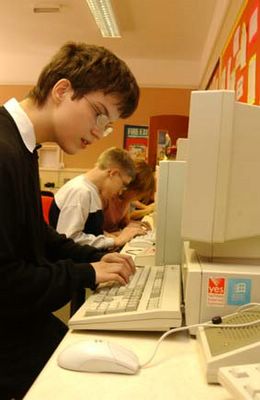St Xavier’s `Visually Impaired Centre’ shows a light at end of the tunnel to visually challenged students...
Independence in life, despite impairment - that’s what the Visually Impaired Centre of St. Xavier’s College, aims to achieve. By far, the visually challenged students of this centre have met with success at achieving their motto. Managing the University syllabus along with making presentations in class, playing cricket and standing shoulder-to-shoulder with every other student in class. Functioning since a couple of years, this centre has about 16 students, who are partially or completely impaired.
But despite the visual challenge, they come across as confidence personified, savvy and versed with technology apart from being ebullient and sprightly.“Professor Sam Taraporewalla, who has been a sociology professor of this college for around 20 years and who himself is visually challenged, took up the initiative to commence this centre for the visually impaired students of this college,” said Sandeep Singh.
Sandeep Singh who is presently doing his SYBA in Sociology, English Literature and History has also been coordinating the task of acquiring writers for the Visually Impaired students for their exams. “We dictate our answers to the writers, who write our papers. Our examination time is also extended by half an hour, as sometimes it takes a while to explain to the writer what we want to be written on the answer sheet,” said Sandeep.
For the forthcoming October examinations, Sandeep managed to get more than enough writers for every student at his centre.The centre has various students studying in the college, and all of them are studying for a Bachelor of Arts (BA) degree.Not just academics, the centre also boasts of a good cricket team. “We have been playing cricket since two years. In fact, last year we won against a match against Ruia College. The match this year will take place in December,” informed Sandeep.
These students have a place of their own which boasts of a Prisma Telivision, with a camera attached to it. This equipment is meant for students with low vision. The camera scans notes, and textbooks put under it, increases the font size as required and displays the write-up on the television screen. The centre also has two computers with the software called ‘Jobs’ that puts to volume every command issued by the students.“The software reads out word documents as well as emails to us. We can even go online, on the sites recommended and do research for our subjects. And we can read newspapers online as well, from the newspapers’ websites,” said Sandeep, who has a keen desire to pursue his studies at the Xavier’s Institute of Communication (XIC).
He cherishes a dream of taking up a career either in freelance journalism or in management.“Earlier we used to go to the National Association for the Blind (NAB), but now we are getting a printer that transcripts our study text to Braille. So no more running around for notes...” informs Sandeep.The centre was given a small space on the first floor behind a staircase, but they will soon be shifting to a much bigger classroom, currently being renovated, that will have all the equipment need for them. Visually impaired they are, but these youngsters do see a ray of hope...



